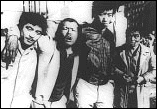|
|
 |
Production Company: Yokohama Document Film Producer, Director, Editing: Watanabe Takaaki Sound: Wada Yasushi Titles: Kanemaru Shigeru Stills: Otsuka Yosuke, Wada Yasushi 1981 / B? / 16mm / 92 min |
| Kotobuki-cho is a section of Yokohama whose residents consist of about 4500 single men, 300 women and 180 children. The day laborers living there have no secure social standing, but they do have one thing: pride in their daily work routine. With their camera and recorder in Kotobuki-cho, the minimal two-person staff of Watanabe Takaaki and Wada Yasushi filmed the often harsh working conditions of the day laborers, while taking in the stories of the workers themselves. The filmmakers decide to conduct a series of interviews following the methodology fostered by Ogawa Productions. This method emphasizes their relation to the film's objects of study. The film in fact ends with a huge banquet put on for the laborers. Watanabe had previously been on the staff of Ogawa Productions' A Song of the Bottom ("Dokkoi ningen bushi," 1975), and had served as assistant director on Magino Story--Raising Silkworms ("Magino monogatari--yosanhen," 1977), and Magino Story--Pass ("Magino monogatari--toge," 1977). Following A Song of the Bottom, Watanabe set out to film the various independent worlds of the laborers. He then began his own independent productions in 1978. Following Living on Kotobuki Street, Watanabe went on to do a follow-up film, Living on Kotobuki Street II ("Kotobuki doya gai--ikiru II," 1984); and a documentary which dealt with the daily lives of resident Koreans, 1985--Kawasaki--Burning Town ("1985--Kawasaki--atsui machi," 1985). In 1993 he produced his first dramatic picture, Alice Sanctuary. |